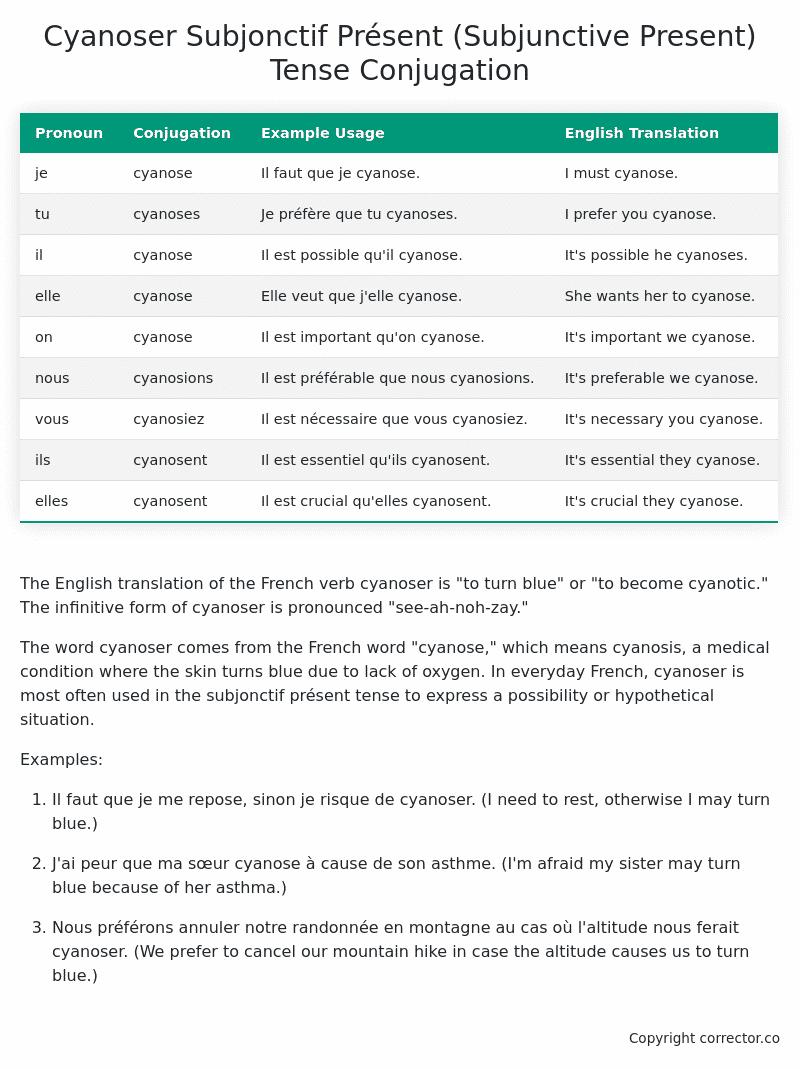Subjonctif Présent (Subjunctive Present) Tense Conjugation of the French Verb cyanoser
Introduction to the verb cyanoser
The English translation of the French verb cyanoser is “to turn blue” or “to become cyanotic.” The infinitive form of cyanoser is pronounced “see-ah-noh-zay.”
The word cyanoser comes from the French word “cyanose,” which means cyanosis, a medical condition where the skin turns blue due to lack of oxygen. In everyday French, cyanoser is most often used in the subjonctif présent tense to express a possibility or hypothetical situation.
Examples:
-
Il faut que je me repose, sinon je risque de cyanoser. (I need to rest, otherwise I may turn blue.)
-
J’ai peur que ma sœur cyanose à cause de son asthme. (I’m afraid my sister may turn blue because of her asthma.)
-
Nous préférons annuler notre randonnée en montagne au cas où l’altitude nous ferait cyanoser. (We prefer to cancel our mountain hike in case the altitude causes us to turn blue.)
Table of the Subjonctif Présent (Subjunctive Present) Tense Conjugation of cyanoser
| Pronoun | Conjugation | Example Usage | English Translation |
|---|---|---|---|
| je | cyanose | Il faut que je cyanose. | I must cyanose. |
| tu | cyanoses | Je préfère que tu cyanoses. | I prefer you cyanose. |
| il | cyanose | Il est possible qu’il cyanose. | It’s possible he cyanoses. |
| elle | cyanose | Elle veut que j’elle cyanose. | She wants her to cyanose. |
| on | cyanose | Il est important qu’on cyanose. | It’s important we cyanose. |
| nous | cyanosions | Il est préférable que nous cyanosions. | It’s preferable we cyanose. |
| vous | cyanosiez | Il est nécessaire que vous cyanosiez. | It’s necessary you cyanose. |
| ils | cyanosent | Il est essentiel qu’ils cyanosent. | It’s essential they cyanose. |
| elles | cyanosent | Il est crucial qu’elles cyanosent. | It’s crucial they cyanose. |
Other Conjugations for Cyanoser.
Le Present (Present Tense) Conjugation of the French Verb cyanoser
Imparfait (Imperfect) Tense Conjugation of the French Verb cyanoser
Passé Simple (Simple Past) Tense Conjugation of the French Verb cyanoser
Passé Composé (Present Perfect) Tense Conjugation of the French Verb cyanoser
Futur Simple (Simple Future) Tense Conjugation of the French Verb cyanoser
Futur Proche (Near Future) Tense Conjugation of the French Verb cyanoser
Plus-que-parfait (Pluperfect) Tense Conjugation of the French Verb cyanoser
Passé Antérieur (Past Anterior) Tense Conjugation of the French Verb cyanoser
Futur Antérieur (Future Anterior) Tense Conjugation of the French Verb cyanoser
Subjonctif Présent (Subjunctive Present) Tense Conjugation of the French Verb cyanoser (this article)
Subjonctif Passé (Subjunctive Past) Tense Conjugation of the French Verb cyanoser
Subjonctif Imparfait (Subjunctive Imperfect) Tense Conjugation of the French Verb cyanoser
Subjonctif Plus-que-parfait (Subjunctive Pluperfect) Tense Conjugation of the French Verb cyanoser
Conditionnel Présent (Conditional Present) Tense Conjugation of the French Verb cyanoser
Conditionnel Passé (Conditional Past) Tense Conjugation of the French Verb cyanoser
L’impératif Présent (Imperative Present) Tense Conjugation of the French Verb cyanoser
L’infinitif Présent (Infinitive Present) Tense Conjugation of the French Verb cyanoser
Struggling with French verbs or the language in general? Why not use our free French Grammar Checker – no registration required!
Get a FREE Download Study Sheet of this Conjugation 🔥
Simply right click the image below, click “save image” and get your free reference for the cyanoser Subjonctif Présent tense conjugation!

Cyanoser – About the French Subjonctif Présent (Subjunctive Present) Tense
Formation of the Subjonctif Présent
Common Everyday Usage Patterns
Interactions with Other Tenses
Summary
I hope you enjoyed this article on the verb cyanoser. Still in a learning mood? Check out another TOTALLY random French verb conjugation!


